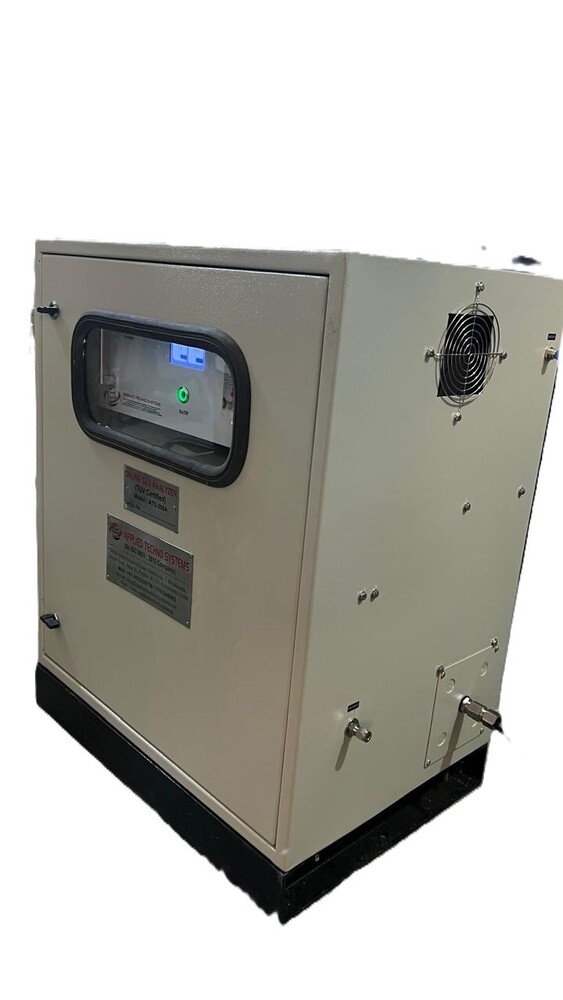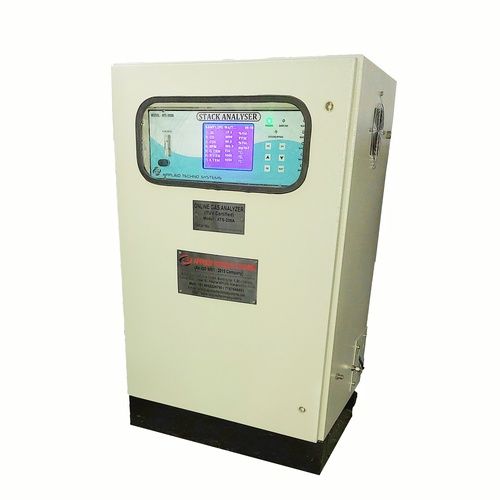- ओस बिंदु मीटर
- गैस विश्लेषक
- पोर्टेबल गैस डिटेक्टर
- नमी और ओस बिंदु विश्लेषक
- धूल मॉनिटर
- गैस निगरानी प्रणाली
- गैस रिसाव डिटेक्टर
- गैस ट्रांसमीटर
- वीओसी लीक डिटेक्टर
- वायु गुणवत्ता निगरानी प्रणाली
- ऑनलाइन सतत उत्सर्जन निगरानी प्रणाली-ओसीईएमएस
- ओस प्वाइंट मॉनिटर्स
- गैस डिटेक्टर
- अपारदर्शिता मॉनिटर
- पोर्टेबल फ़्लू गैस विश्लेषक
- ऑनलाइन एसओएक्स और एनओएक्स गैस विश्लेषक
- मीथेन गैस रिसाव डिटेक्टर
- हाइड्रोजन शुद्धता विश्लेषक
- गैस शुद्धता विश्लेषक
- प्रवाह निगरानी प्रणाली
- निर्माता गैस विश्लेषक
- गैस डिटेक्टर अंशांकन सेवा
- पोर्टेबल गैस मॉनिटर्स
- गैस सेंसर ट्रांसमीटर
Price 325000 आईएनआर/ Unit
Specification
- रंग
- Grey
- उपयोग
- Industrial
- बिजली की आपूर्ति
- Electric
- मटेरियल
- Mild Steel
- तापमान
- सेल्सियस (oC)
- वज़न
- किलोग्राम (kg)
- वोल्टेज
- वोल्ट (v)
- नमी
- 85%RH
Trade Information
- Minimum Order Quantity
- 1 Unit
- भुगतान की शर्तें
- आपूर्ति की क्षमता
- प्रति सप्ताह
- डिलीवरी का समय
- दिन
- मुख्य घरेलू बाज़ार
- , , , , , , , , , , , , , , , , , , , , , , , , , , , , , , , , , , , , , , , , , ,
About
A tri gas or turbine gas analyzer is a sophisticated device used to measure and analyze the concentrations of three specific gases simultaneously, typically in applications related to combustion processes, emissions monitoring, and industrial processes. These analyzers are crucial for ensuring compliance with environmental regulations, optimizing combustion efficiency, and improving overall safety in various industries, including power generation, petrochemicals, and manufacturing.
Key Features:
- Multi-Gas Measurement: Typically measures three gases, such as carbon monoxide (CO), carbon dioxide (CO2), and oxygen (O2), or other combinations like nitrogen oxides (NOx) and hydrocarbons (HC).
- Turbine Technology: Many turbine gas analyzers utilize advanced technologies such as non-dispersive infrared (NDIR) spectroscopy, electrochemical sensors, and chemiluminescence for accurate gas detection.
- Real-Time Data: Provides continuous real-time monitoring and analysis of gas concentrations, allowing for quick adjustments and decision-making.
- User-Friendly Interface: Often includes an easy-to-read display for viewing real-time data, historical trends, and alarm conditions.
- Communication Capabilities: Equipped with digital communication protocols (e.g., Modbus, Ethernet) for seamless integration with control systems and data logging.
- Alarm Functions: Integrated alarm systems alert users when gas concentrations exceed predefined thresholds, ensuring safety and compliance.
Applications:
- Combustion Monitoring: Used in power plants and industrial boilers to optimize combustion processes and reduce emissions.
- Environmental Compliance: Helps in monitoring emissions from industrial processes to ensure compliance with environmental regulations.
- Gas Turbines: Specifically designed for analyzing gases in gas turbine applications, providing insights into performance and efficiency.
FAQs
What gases can a tri gas analyzer measure?
A tri gas analyzer typically measures combinations of gases such as carbon monoxide (CO), carbon dioxide (CO2), oxygen (O2), nitrogen oxides (NOx), and hydrocarbons (HC).
How does a turbine gas analyzer work?
Turbine gas analyzers use various technologies such as non-dispersive infrared (NDIR) spectroscopy, electrochemical sensors, and chemiluminescence to detect and measure gas concentrations.
What industries commonly use tri gas analyzers?
Tri gas analyzers are widely used in power generation, petrochemicals, manufacturing, and environmental monitoring industries.
How often should a tri gas analyzer be calibrated?
Calibration frequency depends on the specific application and manufacturer's recommendations, but it is generally recommended every 6 to 12 months to maintain accuracy.
What are the typical output signals from a turbine gas analyzer?
Outputs may include analog signals (4-20 mA), digital communication protocols (Modbus, Ethernet), and alarm signals for integration with control systems.
Can a tri gas analyzer be used for emissions monitoring?
Yes, tri gas analyzers are essential for emissions monitoring, helping to ensure compliance with environmental regulations and improve air quality.
What maintenance is required for a tri gas analyzer?
Regular maintenance includes cleaning the sensors, checking the calibration, replacing filters if applicable, and inspecting electronic components.
What factors can affect the performance of a tri gas analyzer?
Environmental conditions such as temperature, humidity, and the presence of interfering gases can impact performance. Proper calibration and maintenance can help mitigate these effects.
Are tri gas analyzers portable?
Some models are designed for portability, making them suitable for field measurements, while others are installed in fixed locations for continuous monitoring.
How do I interpret the readings from a tri gas analyzer?
Readings are typically displayed on the devices screen, showing the concentration of each measured gas. Users should refer to the manufacturer's manual for specific details on interpreting results and understanding alarm conditions.
Efficient Industrial Gas Analysis
Engineered for demanding industrial environments, the Tri Gas/Turbine Gas Analyzer offers precise detection and measurement of gas components. Its sturdy build and electric power supply enable continuous monitoring, essential for maintaining safe and efficient operations in gas turbines and associated systems.
Versatile Applications and Reliable Performance
With its compact design and high durability, this analyzer fits seamlessly into power plants, manufacturing units, and various industrial setups. Its adaptability enables operation across a wide humidity range, making it an invaluable tool for accurate and consistent gas analysis.
FAQs of Tri Gas/ Turbine gas analyzer:
Q: How does the Tri Gas/Turbine Gas Analyzer operate in industry settings?
A: The analyzer uses advanced sensors powered by electricity to continuously monitor turbine gas compositions. Its mild steel enclosure protects the device, allowing it to function efficiently in industrial environments with humidity up to 85% RH and temperatures around 15C.Q: What benefits does using this gas analyzer provide to manufacturers and suppliers?
A: This analyzer ensures accurate gas measurement, enhances safety, optimizes turbine performance, and helps manufacturers comply with regulatory standards. Its reliability reduces downtime and improves operational efficiency.Q: When should the Tri Gas/Turbine Gas Analyzer be used in an operational process?
A: It is best used during routine maintenance, system checks, and real-time monitoring of turbine and industrial gas setups to detect changes in gas composition and prevent potential issues before they escalate.Q: Where can the Tri Gas/Turbine Gas Analyzer be installed in a facility?
A: The analyzer is designed for easy integration at key points in turbine systems, near gas pipelines, or in process control rooms. Its lightweight construction facilitates flexible placement throughout industrial sites.Q: What is the process for installing and setting up this gas analyzer?
A: Installation requires connecting the analyzer to a 230V electric supply, mounting it securely using its compact design, and calibrating the sensors based on site-specific requirements. Professional service providers ensure proper configuration and stable operation.Q: How is the device maintained to ensure accuracy and longevity?
A: Regular cleaning of the exterior, routine sensor calibration, and periodic functional checks by qualified technicians are recommended. Maintenance schedules help preserve accuracy and extend the service life of the analyzer.Q: What industries typically use this Tri Gas/Turbine Gas Analyzer in India?
A: Industries such as power generation, chemical manufacturing, processing plants, and other industrial sectors requiring precise gas analysis regularly utilize this analyzer, benefiting from its exporter, importer, and manufacturer support across India.

Price: Â
- 50
- 100
- 200
- 250
- 500
- 1000+
अधिक Products in गैस विश्लेषक Category
सतत उत्सर्जन विश्लेषक
उपयोग : Industrial
मूल्य या मूल्य सीमा : आईएनआर
माप की इकाई : सेट/सेट्स
मूल्य की इकाई : सेट/सेट्स
न्यूनतम आदेश मात्रा : 1
कंटीन्यूअस एचएफ गैस एनालाइजर
उपयोग : Industrial
मूल्य या मूल्य सीमा : आईएनआर
माप की इकाई : नंबर
मूल्य की इकाई : नंबर
न्यूनतम आदेश मात्रा : 1
मटेरियल : Mild Steel

 जांच भेजें
जांच भेजें





 English
English Spanish
Spanish French
French German
German Italian
Italian Chinese (Simplified)
Chinese (Simplified) Japanese
Japanese Korean
Korean Arabic
Arabic Portuguese
Portuguese